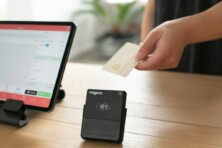Find out how to pay in Brazil and which payment methods Brazilians prefer

How to pay in Brazil: facts on country’s payments market. Source: unsplash.com
Brazil is an amazing country with world-class sights and a unique vibe, which attracts millions of tourists annually. That’s why PaySpace Magazine has decided to deep-dive into its payment market to find out how to pay in Brazil and how do Brazilians pay.
Brazilian market basics
Approximately 66% of Brazil’s population had an internet connection in 2018. Moreover, 90% of internet users browse the web every day, and they spend an average of 26 hours a week online. This rate is the highest one in Latin America.
The country is also ranked 4th globally when it comes to penetration for mobile phone usage, and it is the 5th country in smartphone usage in the world. What’s more, more than 15% of these smartphones are NFC-enabled ones.
Another important fact is that around 81% of mobile owners in Brazil access their bank account via a smartphone app. For example, Banco do Brasil’s app was one of the top 10 most downloaded apps in 2018.
However, according to the Central Bank, more than 25% of the country’s inhabitants have no banking accounts at all and don’t interact with banks by all means. So, how do Brazilians pay?
Leading payment methods in Brazil
Brazilians prefer to use national payment methods. Around 90% of their online purchases are carried out via national payment methods. On the other hand, there is no surprise, since the online payments market in Brazil is restricted by law. Thus, a couple of local banks dominate this market, so they invent their own standards.
Consumers in Brazil are charged an additional tax of 6.38% if they buy goods and services from a foreign site. The same applies to all international transactions, and it is called the 6.38% IOF tax (not to mention the cost of currency conversion). Thus, it makes domestic payment solutions more reasonable and advantageous for both merchants and consumers.
Online payments in Brazil are dominated by credit cards and Boleto Bancário. Credit cards are used in 69% of all online payment transactions. But you have to distinguish national credit cards from international ones. National cards process transactions in Brazilian Reais (BRL), while international ones can process in both foreign and local currencies. What is interesting is that only 20% of Brazilian purchasers have access to international credit cards. This is what really makes it crucial for merchants to have access to local credit cards.
After all, no less than 80% of the adult population has some kind of payment card, and cards are used to pay for 30% of all household expenditures, according to the Brazilian Association of Credit Card Companies.
Boleto Bancário is the leading push payment method that enables users to pay for goods and services online, in cash at any bank branch, at ATMs, or electronically via online banking. It is regulated by the Brazilian Federation of Banks.
Boleto Bancário represents around 15% of all payments in Brazil. That’s why this payment option is a must-have for enterprises operating in the country.
5 most popular payments methods in Brazil:
- Boleto Bancário
- Visa
- Mastercard
- American Express
- ELO
Alternative payment methods in Brazil
- Co-branded Cards. These cards can be used not only at selected retailer’s stores but at different points of sale as well (it mostly depends on the type of card and the brand you’ve chosen). They are issued by department stores (C&A, Renner, Marisa, Pernambucanas, etc.), grocery stores (Carrefour, Pão de Açúcar, Extra), pharmacies and others.
- Débito Automático (direct debit in Portuguese). This payment option is used for utility payments only (gas, electricity, etc). It has to do with the fact that Brazilian banks normally allow only such companies to charge the bank accounts directly. A lot of payment providers were eager to implement this system in e-commerce, but all their efforts were defeated and have failed.
- E-financing. It is available at some banks (such as Itаú, Вrаdеsсо, and Ваnсо do Brasil, for example). It is hard to call this payment method the most frequently used one since banks require a client to have a pre-approved credit with them (it is about the particular bank you’re going to deal with) before the transaction.
- E-wallet service. Brazilian e-wallet service is not that different from the one in other states. We’ve already mentioned above, that such companies as PayPal, МеrсаdоРаgo, and РауРаl, provide clients all the range of e-wallet services (storage, top-up option, payments, etc).
Leading payment service providers in Brazil
Brazil’s payments market has four major acquirers, which can process e-commerce transactions: Cielo, Rede, Santander, and Adyen.
Here’s the list of other top payment service providers and payment gateway services:
- Allpago – accepts payments in Latin America.
- Braspag– facilitates banking card transactions all over Brazil.
- Digital River– a full-scale payment provider.
- Ikajo International – global PSP, also operating in Brazil.
- maxiPago!– a payment gateway platform in Latin America.
- MercadoPago – an e-wallet and payment system) developed by the online marketplace’s MercadoLibre creators.
- PagBrasil – a Brazilian online payment gateway, which processes for cross-border and national business. Its exclusive Boleto Flash solution operates faster than most other options.
- PagSeguro – an e-wallet that allows merchants to accept the most popular payment methods in Brazil.
- PayPal – a global payment company, needs no introduction.
Expert’ insight

Brazil is very particular when it comes to payments. With roughly 55 million unbanked adults and 60.1% of households that started the year 2019 with some sort of debt – with as much as 22.9% of them defaulting on payments and 9.1% stating they cannot pay their debts – it is no surprise that cash and alternative payment methods, such as boleto bancário, still play a huge role in the country.
The recent Brazil Digital Report by McKinsey pointed out that 47% of payment transactions in Brazil are carried out in cash. Among consumers paying with credit cards, the vast majority chooses to pay in monthly installments. This places credit cards as the main source of debt in the country.
Another particularity is that credit card payments are often restricted to transactions in local currency. For online payments, such limitation means that international merchants who do not work with a local payment partner have poor conversion rates, which can significantly impact their revenue, particularly when they are acquiring consumers through digital marketing campaigns.
Alternative payment methods, specially boleto bancário, have a huge following in the country. According to the Central Bank of Brazil, 3.7 billion boletos are paid each year, which translates into over 10 million transactions per day. However, usually, only one in two boletos generated online gets paid. This is why at PagBrasil we created Boleto Flash®, which is a modern version of the old boleto, offering payment confirmation in less than one hour, as opposed to up to three business days, as well as relying on a mobile-friendly layout.
How to pay in Brazil
As PagBrasil’s specialist mentioned above, cash is still the main payment option in the country.
As a tourist coming to Brazil, you’d better get some local currency. It is called real (plural = reais) and is made up of 100 centavos. It is written with the help of the R$ symbol. The currency exchange symbol for the real is BRL. This currency’s rate remains relatively stable since its launching in 1994.
The dollar is not legal tender in Brazil, but you can use it for tipping or for buying items at some tourist locations.
Tips for a tourist on how to pay in Brazil:
- Find out the mid-market rate by using an online currency converter before you exchange your money. This way you’ll avoid poor exchange rates, often offered at airports and hotels.
- Don’t count much on ATMs, as many of them don’t accept foreign cards. And even if you’ll manage to find the one that does, your bank will probably charge you a huge fee for international withdrawal.
- Traveler’s cheques are not accepted as a form of direct payment in Brazil.
- Contact your bank before going to Brazil. Maybe your bank has some special offers for travelers to this country. There are also some international banks, operating in Brazil, like Santander, Citibank, BNP Paribas, Mizuho, etc., which may simplify your financing on a trip.
- Credit and debit cards of all the major global networks are accepted in Brazil. Many POS terminals in the country can handle contactless payments, as well. However, keep in mind that small stores and cafes in Brazil not always accept card payments, so you’ll need some cash anyway.
- To avoid hidden fees while abroad, it is better to disable Dynamic Currency Conversion.
- Apple Pay, Google Pay, and Samsung Pay are ready for you to use in Brazil.
SEE ALSO:









